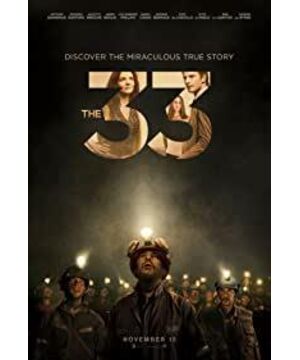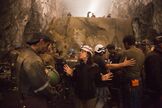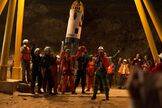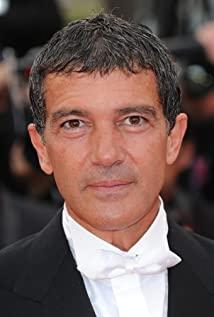(Thanks to Time.com Babies for speaking a lot of my heart)
1. Story: Adapted from a real event in Chile.
1. Real story: On August 5, 2010, a landslide accident occurred at the San Jose copper mine in Chile. 33 miners were buried 700 meters deep underground. They hid in the refuge room and depended on very little food to maintain their lives. The Chilean government sent an engineering team to excavate and drill, and a 135-meter-wide, 700,000-ton rock lay on the top of the miners, making rescue difficult. After several twists and turns, on October 13, 2010, the miners finally got out of the darkness after staying underground for 69 days and all escaped danger. This is what actually happened.
2. Video: Try to truly reflect the whole process of a mine disaster rescue work.
The first half is about the mine accident and the search for 33 besiegers. It is rarer that the second half tells the story between the rescue team (people of the whole country) getting in touch with the trapped miners and the completion of the rescue.
3. Turning point: When faced with technical difficulties and authorities wanted to give up, the miners’ families did not lose hope first.
From beginning to end, the film focuses on these people—the miners’ fathers and mothers, wives and children, brothers and sisters, to show their concern and love for their lost relatives. The film links the persistence of the government with the persistence of the people, and promotes humanistic thinking and humane care, and also makes a big advertisement for Chile.
4. The trapped people are psychologically strong: When the miners are desperate, most of them choose to believe in the government and their families. Also, believe in faith.
Whether you are alive or facing death or food shortages, having faith and family to support you can at least ease your tension.
The obscenity of "food and family" is the greatest manifestation of the will to survive.
5. Full of positive energy. The reason why this film scored more than last year's "Everest" (EVEREST) is that the lens language of this film gives people positive energy, can arouse the positive side of the audience, and make the audience cherish their life more after watching it.
6. Disadvantages: Many scenes that could have enough tension and dramatic conflict were not used well in the film, so this film did not become a masterpiece.
For example, the mine owner with his hands spread out, such as the miner who treats his mother with a cold and drunken attitude, such as the brother and sister who ignore each other.
2. Visual effects:
1. Through the khaki filter, the people and natural customs of Latin America (Chile, Bolivia) will be shown.
The yellow sand dunes, the optimistic miners in the dark mines, the singing family members, and the lively bonfire convey a scorching Latin American people's optimistic attitude towards life.
2. It clearly shows the internal structure of a copper mine.
It turned out that the truck drove into the hole, and it took an hour to drive to the bottom! Once it collapses, the long-term difficulty can be imagined.
3. Actors: Acting is not the focus of this film.
1. Antonio Banderas: The protagonist plays his due diligence. Playing Mario is everyone's leading big brother. Look for an escape ladder at the beginning of the landslide and save yourself; limit and evenly distribute only food; give up your headlight to the newcomer; cheer for Alex who tried to commit suicide: "You have a wife and a child to be born, they need You." To everyone's misunderstanding, he made clear the goal "We have to work together to get out of here." The leadership of the leader directly determines the final result.
2. Juliette Binoche's role is inconsistent. It's a little awkward for a French woman to play a Latin sister, and there's not much for her in the role.
3. The other supporting roles are basically Latin, and they can play in their true colors.
4. Others:
1. The soundtrack of this film is master James Horner, who died in a flight accident in June 2015. This is his last soundtrack film. He has composed scores for many famous films such as "Titanic", "Braveheart", "Braveheart" and "Avatar".
2. The real event described in the film is the second rescue case in mining history through drilling and drilling. In January 2016, when a mine accident occurred in Pingyi, Shandong, China, this method was also adopted for rescue. It was the third case in the world and the first successful case of drilling rescue in the history of Chinese mines.
3. The film's depiction of Chilean President Pinera is not entirely positive, showing his opportunistic side, worried that the failure of the rescue operation will affect his reputation. But Pinella himself is very generous, explaining the reason is "I believe in Juliet • Binoche".
4. The role of Juliette Binoche was originally scheduled to be played by Jennifer Lopez. The latter dropped the film because of the recording of "American Idol."
5. In the film, the youngest father, Alex Vega, is the first miner to rise to the ground to be rescued. In reality, however, he was the tenth person to rise to the ground.
Summary: Bringing the original Chilean mine disaster to the screen, the story is not particularly exciting, but because of the rare miracle of survival, and because of the warmth and cohesion between people, it will be enough to move you.
View more about The 33 reviews











